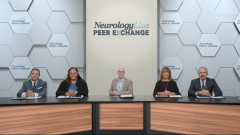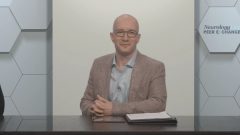
Brain Health in Multiple Sclerosis
An expert panel talks about the preservation of brain health regarding the use of sphingosine 1-phosphate receptor modulators to treat multiple sclerosis.
Episodes in this series

Stephen Krieger, MD: One of the topics that are being talked about a lot in MS [multiple sclerosis] nowadays and here at the Congress of ECTRIMS [European Committee for Treatment and Research in Multiple Sclerosis] certainly is being discussed is the notion of brain health overall. So, we’re talking about an aging population. We’re talking about comorbidities. Many of them can sap brain health. You mentioned smoking, diabetes, and other vascular risk factors. And let’s speak a little bit about how you consider brain health in your practice Dr Bandari. Let’s think about it from the perspective of what is brain health and then we can think about how our medicines might impact that.
Daniel Bandari, MD, MS: The concept of brain health today, the way that we’re looking at it, I believe is a little different. With more interest in the cognitive function in MS and the viability of extending work life more than anything else and the quality of life. All of those bring 2 elements. One is phenotypic part of the brain health, which would include everything they’re able to do including proper cognitive function, continuing with their high demand work, family style, all of those things. And the other part of it that I believe is really important is the fact that the way these medications have been able to affect the MRI metrics and radiologic aspect of it more than anything else.
As you mentioned, one of the biggest topics today is the brain volume element when it comes into it. Now, with respect to that, obviously, we were always looking at cortical brain volume vs the total brain volume. But today we look at more in-depth nuclei of the brain and the correlations between them. And I’m intrigued because there is great information being presented at this conference looking at all those aspects from both phenotypic presentations correlating with the radiological aspect of it.
Stephen Krieger, MD: Absolutely. One of the pieces of work presented at ECTRIMS looked at newer medicines and how well they work at preventing brain volume loss. There have been a lot of nice papers on specific S1P [sphingosine 1-phosphate receptor] modulators like ozanimod in preventing loss of brain volume and gray matter volume. In work presented here “Association of brain volume loss and long-term disability outcomes in patients with multiple sclerosis treated with teriflunomide”, Till Sprenger MD UCSF Medical Group, San Francisco, California, and colleagues looked at how ponesimod similarly prevents brain volume loss. So, a pro-brain health takes on what a selective S1P modulator might do. One of the distinctions between aging, the consequence of aging, and the consequences of MS are which parts of the brain, which nuclei are atrophying as they do normally vs what is MS doing?
Prior work “Thalamic atrophy in multiple sclerosis: A magnetic resonance imaging marker of neurodegeneration throughout disease” by Christina J. Azevedo MD, MPH, Keck School of Medicine of USC, Los Angeles, California, and colleagues looked at thalamic volume loss as being much more specific to MS pathophysiology rather than just overall age. In some of the newer work on how S1P modulators prevent brain volume loss, they found that in younger patients these medicines do a better job at preventing brain volume loss because most of that is being driven by the disease. Whereas in older patients, brain volume loss is driven by aging and other aspects of brain health. So, Dr Hughes, do you distinguish at all when you’re looking at scans in practice? Do you distinguish quantifying brain volume itself? Are you starting to look at these different nuclei, as Dr Bandari said, thalamus vs others, or is that still on the horizon?
Bruce Hughes, MD: It’s definitely, as far as day-to-day practice, it’s still a challenge for most centers to get accurate reads on deep gray matter structures vs cortical gray matter atrophy vs whole. But just knowing that it’s there, and there so much earlier in MS than we previously thought. This is novel information over the past 10 years. That we thought the atrophic portion of the disease came later and not earlier, but now we’re finding out that it’s earlier. So how that directs me is that I’m very interested in medications that not only impact physical disability progression but cognitive disability progression. And I think that ties in well with atrophy and we know that brain atrophy ties in well with a physical disability down the road. If we have early atrophy, not a good thing. I look at it in the fact that we have, as you mentioned, very good data with a newer agent, ozanimod. Now, with ponesimod, we have the same data showing this similar finding and I think it’s important to separate. People say, “Is that a class effect?” And when we look at fingolimod, it’s not very centrally penetrant like the newer agents are. I think that is why these newer agents, for me, are a better option.
Stephen Krieger, MD: I think that makes sense. You talk about the class effect, and of course, we talk about that in principle. But then there are these nuances both from a safety and efficacy side of things. We talked about how the newer S1P modulators, by being more specific, may not have the same safety issues as the original in the class. And then, to your point, by their mechanism and perhaps greater brain penetrants, they may have more, or different efficacy and we can measure it in these newer ways than older medicines in the class. I think that’s a nice modern take on it.
Bruce Hughes, MD: And I think why this result is even more impactful is the data for teriflunomide on brain atrophy is really good, and this was superior to an agent that is really good not just superior to placebo.
Stephen Krieger, MD: That’s been talked about with respect to disability end points in trials against teriflunomide also. Not every agent that’s gone head-to-head against teriflunomide has been statistically significantly better on disability and I think that’s partly because that drug does do something to prevent disability and we’ve done that for a decade. It’s seeing parity in some ways and superiority in others, I think, is meaningful.
Heidi Crayton, MD: I’d like to add I think this whole S1P receptor modulator class has really brought more focus on the ability to control atrophy and started the conversation about gray matter atrophy and deep gray matter structures like Dr Daniel Bandari was referring to. And I think, for me, it’s really helped. It’s an aha moment that yes, of course, those deep gray structures are where processing occurs and that’s the biggest complaint of our patients. I think it’s definitely put more focus on elucidating the ideology of some of their complaints.
Stephen Krieger, MD: Also, even if we can’t measure it in practice, that’s not a reason to not endeavor to protect it.
Bruce Hughes, MD: True.
Heidi Crayton, MD: 100%.
Stephen Krieger, MD: It’s not angels dancing on the head of a pin. These things probably really do matter even if we don’t quite have the metrics to look at it in everyday routine care. But we will and then when we do, it’ll be good to have been treating it in a proactive way before we see something and realize that we’re too late to do something about it.
Daniel Bandari, MD, MS: Well, it entices us to look for the things that we don’t see yet but know exist. And I think that’s one of the key elements that come into it. And we want to know the things that we know it exists, but we don’t know yet I think more than anything else.
Stephen Krieger, MD: I think that’s one of the themes of this year’s ECTRIMS is how are people in practice and in research looking harder, looking below the surface of what we typically see both clinically as well as with imaging and then even with immunomarkers and emerging blood biomarkers. We’re hearing a lot about that in our field now. I think brain health and looking for previously invisible things are 2 themes I’ve been picking up on at this conference.
Heidi Crayton, MD: An iceberg analogy of the past.
Stephen Krieger, MD: Indeed. Well, listen you can’t have me talk about MS without my thinking in terms of what’s hiding below the surface. But we keep getting better at looking below it.
Mitzi Williams, MD: I think it’s very exciting, right? I remember when we only had 1 drug that had atrophy data. And so, now to see this becoming a part of the regular score of things that we look at will help push us closer to being able to look at it in real life and with our patients to be able to make treatment decisions based on some of these data points.
Daniel Bandari, MD, MS: And if I may just add 1 last element into that, is that the data that Sirin Gandhi neurosurgery resident, Barrow Neurological Institute in Phoenix, Arizona has presented in this meeting, looking at that element of being able to use 1 of the most advanced MRI evaluation metrics rather than using The 2017 McDonald Criteria, grade 3 or 4 for example, using MAGNIMS criteria. In order to bring that into it has been very exciting also. That has shown and proved what we knew already in the previous criteria, now with this new generation of medication can be applied to a new generation of MRI evaluation.
Stephen Krieger, MD: It’s true and I think a lot of people in the practice might not be applying MAGNIMS criteria themselves. Counting the numbers of lesions and thinking about which category they fit into, which speaks to why it’s nice that there are emerging technologies that do a lot of that quantification for us. These are things like, icometrix or Octave, which are aggregating quantified measures.
Daniel Bandari, MD, MS: NeuroQuant.
Stephen Krieger, MD: NeuroQuant. Supplements what we’re able to see with our own eyes. That’s another theme that I think we’re getting out of this conference.
Transcript edited for clarity
Newsletter
Keep your finger on the pulse of neurology—subscribe to NeurologyLive for expert interviews, new data, and breakthrough treatment updates.























